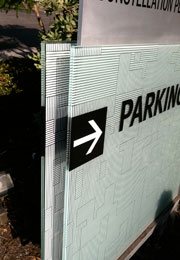There are many different types of sign panels that are available for cutting and decorating in sign making and there are just as many different ways today to decorate them.
This article will take a closer inspection of working with three such panel materials—aluminum, aluminum composite, and plywood.
Aluminum. There are numerous advantages to using aluminum panels for signage applications. This material is lightweight (about one-third the weight of steel), highly durable, non-corrosive, easy to form, and accepts multiple finishes (liquid paint, powder coating, and anodizing).
If you’re going to be painting aluminum, exterior acrylic polyurethane paint is recommended.
The essential tools you’ll need for painting aluminum include DA sanders with the correct grit sandpaper to prepare the surface before priming and painting, a good spray gun, and personal protection equipment.
“All painting should take place in a properly ventilated area,” advises Bill Freeman, vice president of Architectural Sales at Howard Industries.
Proper cleaning and the use of undercoat (primers) such as etching and/or epoxy primers work best and help with adhesion.
“Be sure to follow the paint manufacturer’s instructions for flash time and coating thickness (mills),” adds Freeman. “Also be aware of any change in ambient temperature, which affects the performance and longevity of coating.”
When decorating aluminum panels with vinyl, the tools you’ll need in order to achieve a smooth application include vinyl transfer tape, masking tape, a ruler/straight edge, application spray, and a squeegee and/or an application roller.
Freeman recommends using high-performance vinyl to give these signs longevity.
“Make certain the paint has fully cured before applying any vinyl graphics, especially those that are reflective in nature,” he says. “This eliminates the chance of escaping gases causing the vinyl to bubble.”
If the vinyl-covered aluminum sign is going to be installed in an area where vandalism is going to be an issue, consider applying a protective clear coat to the panel after the vinyl has been applied. “This creates a protective barrier against graffiti and unwanted removal of graphics,” explains Freeman.
There are other decorative ideas that can be employed for aluminum panels as well.
“Aluminum panels may be adorned with routed filigree designs for added sign allure,” reveals Freeman. “And graphics applied directly to the panel surface using a flatbed printer is becoming popular too.”
Aluminum Composite (ACM). From high-end architectural signs and corporate identity projects to simple post-and-panel and wall-mounted signage, ACM sign panels can be painted, covered with vinyl, or printed directly onto the surface with very little prep required.
A type of flat panel that consists of two thin aluminum sheets bonded to a non-aluminum core, ACM can be fabricated into three-dimensional shapes or easily seamed together to make larger signs.
Garrett Thompson, national sales manager, Sign and Digital Products, at Laminators Inc., says, “It’s really up to the imagination of the graphic artist/designer/sign maker as to what they can do with this material.”
Thompson stresses the importance of following the application recommendations of the paint, ink, or vinyl/film manufacturer and to test a small area prior to painting the whole surface.
“Automotive acrylic enamels, polyurethanes, and lacquers offer an excellent finish by scuffing lightly with fine-grit sandpaper prior to spraying,” he says.
Thompson states that the following vinyl products work best on ACM: Pressure-sensitive vinyls; polyester films, intermediate/high-performance films, translucent films, reflective films, and digital print vinyls.
Aluminum composite material can accept both screen print inks (multi-purpose inks or synthetic gloss enamels) as well as digital print inks (aqueous, solvent-based, UV-curable, and latex).
It’s important to note that these types of panels are ideal for usage in both indoor and outdoor signage applications.
“However, if these panels are going to used in outdoor environments, we recommend applying a high-quality UV inhibitor to the finished graphic, so as to protect against UV degradation,” states Thompson, noting that his company’s panels require no edge seal whatsoever (unless purely for aesthetic purposes). “This will also help extend the life of the sign.”
Plywood Core. Although plywood composites cannot be fabricated into 3-D shapes, it is ideal for hanging signs since it’s easy to fasten to; provides a solid, sturdy surface; and can take a beating.
“There’s a reason plywood has been the sign substrate of choice for hundreds of years,” says Thompson.
According to Thompson, you can apply automotive acrylic enamels, polyurethanes, lacquers, and Krylon® sprays to vinyl surfaces on plywood core material.
In addition to sun (UV) protection, sign makers should be aware that water is another major enemy of wood. So in exterior applications, be sure to finish the panel edge to protect against any water penetration.
By Jeff Wooten
Photos (top to bottom): Peter Perszyk, Peter Perszyk, Howard Industries.











